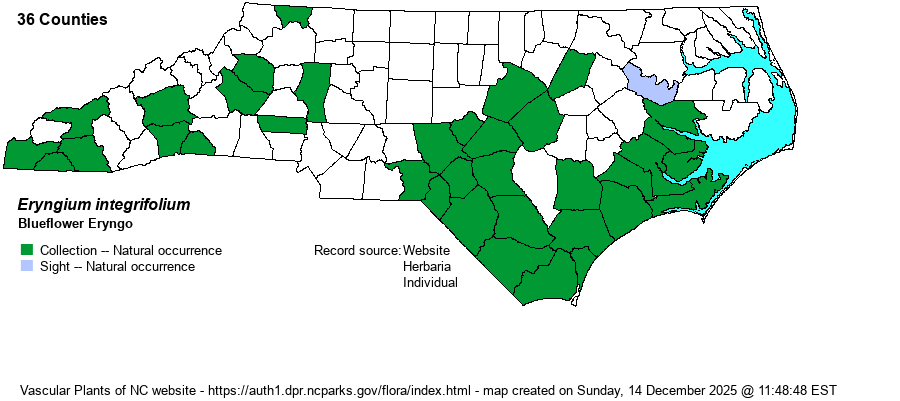| Author | Walter | |
| Distribution | Present essentially throughout the southern 2/3 of the Coastal Plain, north to Martin County, and as it has been found in southeastern VA, it could occur to the VA state line. Also scattered in the Mountains and western Piedmont, and along the eastern edge of the Piedmont. Clearly a disjunct range in the state, as it is absent from most of the central and eastern Piedmont and parts of the northern Coastal Plain.
This is a Southern species, barely ranging north to southern VA and southeastern OK, and south to northern FL and eastern TX. | |
| Abundance | Fairly common in the coastal Longleaf Pine (Pinus palustris) belt from Craven and Carteret counties to the SC border; uncommon to infrequent over most of the rest of the Coastal Plain, though very rare to absent in the northern portions. Rare to locally uncommon in the Mountains, but very rare and declining in the western part of the Piedmont (with likely local extirpations); very rare in the eastern edge of the Piedmont. | |
| Habitat | This is a wetland species, of pine savannas, wet pine flatwoods, sandhill seeps, montane bogs, montane seeps, and other damp places, typically in acidic soil. |
| Phenology | Blooms from August to October, and fruits soon after flowering. | |
| Identification | This is a medium-height herb, to about 1.5-2 feet tall, somewhat succulent, with some branches in the upper portions. The basal leaves are lanceolate, about 3-4 inches long and 1-2 inches wide, with crenate to serrate margins and a blunt tip. The stem leaves are smaller and shorter than the basal leaves. The inflorescence is a wide, flat-topped umbel, with numerous umbellets, each subtended by spiny bracts. The flowers in each of the ball-shaped umbellets is light to medium blue. The basal leaves of this species are much shorter, and thus relatively wider, than are those of E. aquaticum and E. ravenelii. This is a beautiful species of our savannas, bogs, and wet seepages, usually in full sun to mostly sunny places, as there are relatively few blue-flowered species in these habitats. | |
| Taxonomic Comments | None
| |
| Other Common Name(s) | Savanna Eryngo. More references use Blueflower Eryngo as a common name than do Savanna Eryngo, but as several other species have blue flowers, and as this a species of savannas, Savanna Eryngo is probably a better name to use, at least in NC. | |
| State Rank | S4 | |
| Global Rank | G5 | |
| State Status | | |
| US Status | | |
| USACE-agcp | FACW link |
| USACE-emp | FACW link |

